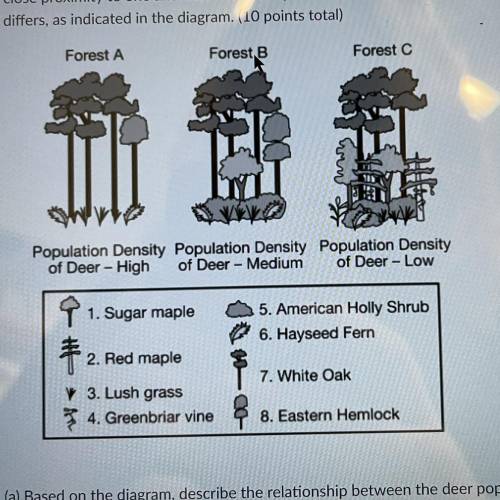
Advanced Placement (AP), 14.12.2021 01:00, colyernicholas44
(a) Based on the diagram, describe the relationship between the deer population and biodiversity in forest A
(b) Based on the information in the diagram, identify a plant species in an area of low deer density
that would serve as an indicator that the density of the deer population is increasing, even if you
could not directly observe any deer.
(c) Wolves are natural predators of deer, but wolf populations are not found in any the three forests in the diagram. Identify the forest in which the diversity of plants would be most affected by the reintroduction of wolves and explain how reintroducing wolves would cause that effect.
(d) Wolves invest much time and energy into the care of relatively few offspring. Identify the reproductive strategy of wolves.
Deer are common tick hosts. Possums are hosts for young ticks and eat many of the young ticks
before they can feed. Other species such as squirrels and mice are not as effective at removing ticks.
(e) A hiking club that frequently visits trails in Forest C has requested that the city take action by
trapping and relocating possums away from Forest C to reduce the tick population. Make a claim
using evidence to agree or disagree with the hikers' request.
(f) Homeowners living near Forest C believe deer are eating their lush grass. Make a claim based on
evidence that supports or refutes the belief of these homeowners.
Some forested areas of the country have large, flat-topped boulders left behind by glaciers. The tops
of the boulders have become covered with lichens, grasses, shrubs, and even some small trees. Deer can jump onto the top of shorter boulders to graze; however, none of the deer can jump onto the tallest boulders. Scientists sampled vegetation from the tops of both short and tall boulders, some of
which were grazed by deer and some of which were not. Scientists observed that the most diverse
plant growth occurred on the boulders that could not be reached by deer.
(g) Identify the dependent variable for the investigation.
(h) Identify one variable that was not mentioned in the description above that could affect the
results of the investigation and explain how that variable could affect the results.
(i) The boulders studied in the investigation described above were deposited by a glacial retreat
approximately 14,000 years ago. Describe the steps that likely led to the formation of soil in the
study area.


Answers: 2
Other questions on the subject: Advanced Placement (AP)

Advanced Placement (AP), 23.06.2019 15:30, yousifgorgees101
Usha is giving a presentation on the cardiovascular system. one of her slides shows a diagram of the blood moving from the heart to the arms and legs. which type of circulation is the slide illustrating? systemic circulation pulmonary circulation systolic circulation diastolic circulation
Answers: 1

Advanced Placement (AP), 24.06.2019 06:00, tyquanvicks13
In a government based on the consent of the governed, who has the ultimate authority?
Answers: 2

Advanced Placement (AP), 24.06.2019 08:00, tayleeanntabeln2097
What are the countries in south asia?
Answers: 1
Do you know the correct answer?
(a) Based on the diagram, describe the relationship between the deer population and biodiversity in...
Questions in other subjects:

Spanish, 08.07.2019 18:30


History, 08.07.2019 18:30












